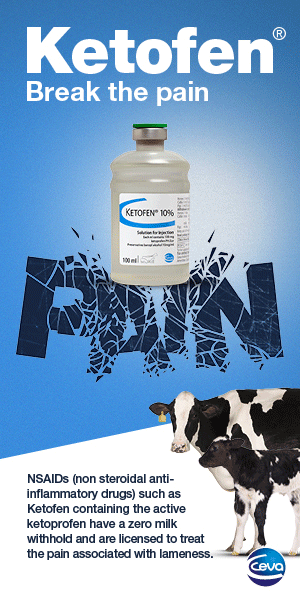Ninety percent of lameness in dairy cows arises from conditions of the feet. Claw trimming can improve cow mobility (locomotion) if done correctly. Timely claw trimming can also prevent lameness. However, if performed incorrectly, then claw trimming may be a waste of time, or worse still it can exacerbate lameness.
The 'Dutch 5 Step method' of claw trimming (see below) is the internationally accepted approach to effective claw trimming which is best implemented following training.
Dutch 5 steps method
Functional Trimming
1) Trim toe length to correct length
2) Match untrimmed claw length/level
3) Model (dish) out sole ulcer site
Corrective (Therapeutic) Trimming
4) Relieve weight off painful claw
5) Remove loose/under-run horn and hard ridges in high risk zones

Fig 1: A foot from an animal kept at pasture.
Why is claw trimming important?
Concrete tends to be abrasive and concussive, increasing wear on the outside heel while stimulating horn growth on sole and wall. Overgrowth with loss of normal shape can contribute to altered load bearing during locomotion. This results in more concussionwith further overgrowth and imbalance leading eventually to lameness in some animals - a vicious circle.
A claw that is badly trimmed might be unstable on concrete, might have too little sole or wall to protect it, creating pain and discomfort for the cow, and increasing the risk of lameness in the future.
Once a cow has chronic lameness, then the natural wear associated with normal mobility and locomotion are lost and imbalances between claw horn growth and wear become a recurring or permanent problem. Chronic lameness is in part due to irreversible scaring and disease of the bone.
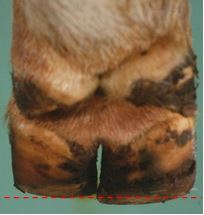
Fig 2: A foot from an animal kept on concrete the concussive forces increase horn growth, increasing loading, with increased wear, particularly the outer wall of the heel of hind feet
Cost-effectiveness of claw trimming
In the UK it is estimated that there are 55 cases of lameness per 100 cows per year, with the average case costing £178, and the "average" herd losing approximately £10,000 per 100 cows every year. A single case of lameness costs about the same as claw trimming 18 cows using a professional claw trimmer. This makes regular, claw trimming extremely cost-effective for most herds in the UK if done correctly, and may reduce other problems such as infertility. In addition to reducing lameness and improving mobility, claw trimming can improve cows grip on concrete, potentially reducing injuries and improving bulling activity. Once damage to claws and stretched tendons has occurred then often it will remain for the lifetime of the cow, adding to the urgency of claw trimming for cows with the early signs of claw overgrowth.
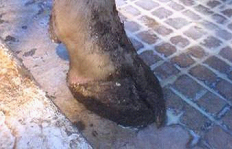
Fig 3: Note overgrown inner claw
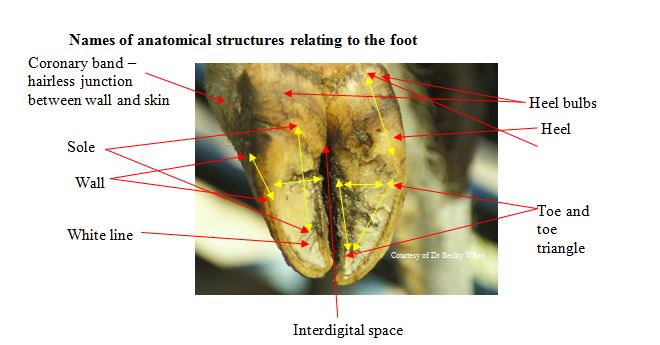
Before you start - have the right equipment.
With the right handling system it should not take more than one minute for one person to load and unload the cow in the crush. A system must be altered if it causes distress or injury to either the trimmer or the cow. It should be made as easy as possible to treat a cow at any time on any day.
Practical claw trimming instructions for Holstein-Friesians
1. Correct the toe length - for average Holstein-Friesians measure 8 cms from top of where the claw goes hard (8.5-9 cm from top of coronary band). This length may need adjusting according to age, breed, disease and if the wall at the front of the toe is curved.
For hind feet, start with the inner claw (most normal) first in step 1.
For front feet, reverse the claw order throughout this method i.e. outer=inner and inner=outer.
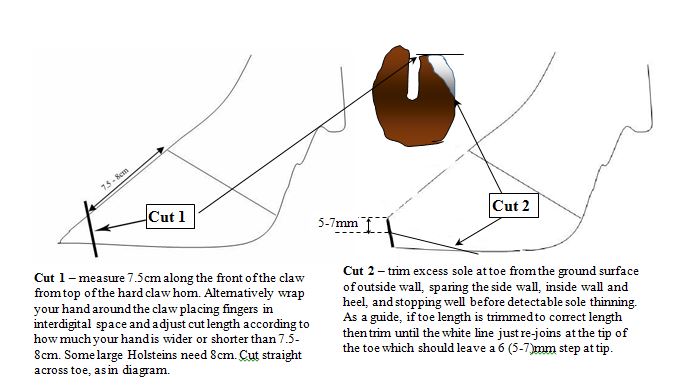
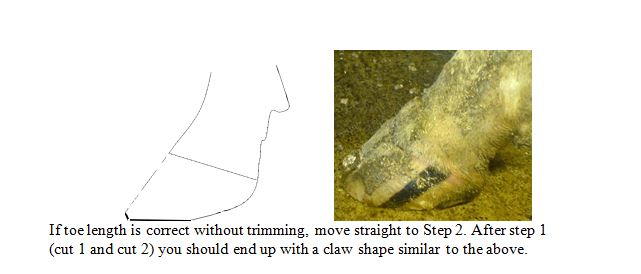
2. Trim the partner claw to match length and balance to first claw (if correct)
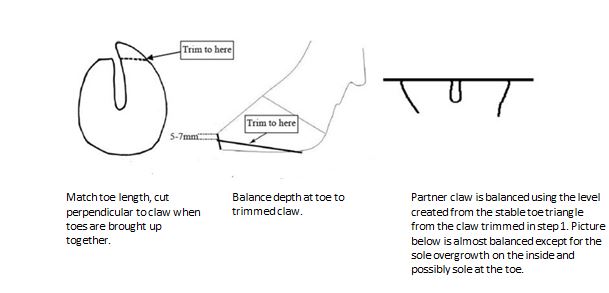
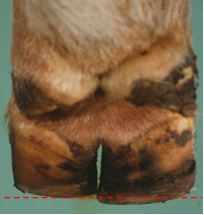
Inner claw Outer claw
The outer hind claw is slightly larger and more likely to be misshaped or affected by bony change around the coronary band. Therefore, erros occur if this claw is measured. Instead, match toe length and levels to the correctly trimmed first claw. Always err on the side of caution, especially in sound and healthy animals. Step 2 correct any obvious imbalances in weight bearing between inner and outer claws.

While equal weight bearing is probably ideal, for some animals a naturally shallow heel on the inner hind claw can leave the outer claw over-trimmed and exposed to bruising if completely equal weight bearing is attempted. Therefore, caution is advised when trimming down heels, with frequent checking of sole depth and slight imbalance preferred to thin soles in the heel of the outer hind claw. In sound, healthy animals the heels rarely need much trimming.
3. 'Model' (Dishing out, hollow out) the ulcer site
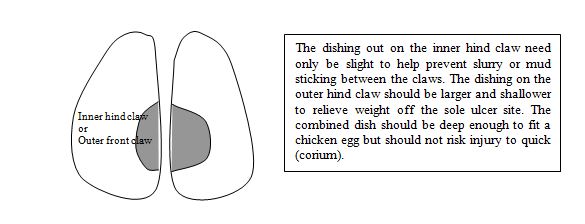
This step transfers weight from centre of the sole onto the harder wall, toe triangle and more cushioned heel.
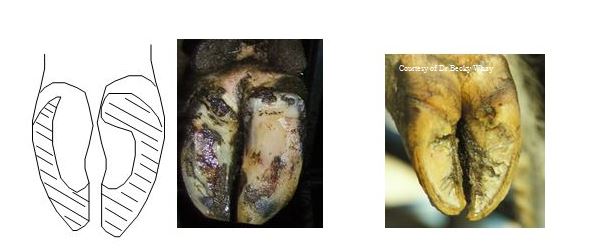
The claw has evolved to absorb concussive forces, bear weight and pump blood through the heel, wall and sole next to the wall. The heel acts like the suspension, absorbing concussive forces as the foot strikes the ground. The wall is the hardest and toughest part of the claw, able to withstand the wear and tear from harsh underfoot surfaces. Carefully dishing out the central sole will aid this function. To be effective, a greater dished area by 2:1 is required for the outer hind claw compared with the inner9.
That completes the functional trim. For the functional trim, only excess horn should ever be removed. It also prepares the foot for inspection prior to the corrective trim.
Corrective trim - steps 4 and 5
For the corrective trim, functional shape of the claws must be preserved and lesions prioritised for corrective trimming. Many healthy cows receiving a routine trim will have no painful lesions or lesions likely to cause lameness. In these cases, claw trimming can move to the final step (5).
In lame cows it is possible to identify painful lesions by:
-
Locating a lesion associated with exposed "quick".
-
Triggering flinch behaviour when light pressure is applied to the painful claw, either using thumb pressure, pressing on the skin next to the claw or by using blunt "pincers" to apply focal pressure. Similarly, the cow may 'tense' when the claw is gently twisted.
-
Heat, swelling, odour or redness affecting one claw or digit (one side of the foot).
By taking a thin 'skim' of horn from the sole surface of the painful claw, tracts of diseased horn may be spotted and pain confirmed using blunt pincers (or thumbs).
4. Relieve weight off a painful claw - trim down the back 2/3 of painful claw and/or fix a block to the healthy claw

Relieving weight off a painful claw can be achieved in two ways. If there is a good depth of heel horn on the unaffected claw, then the heel horn on the painful claw can be trimmed down (red arrows below). Additionally, a plastic, rubber or wooden block can be applied to the healthy claw for 4-6 weeks. Almost all cows with sole ulcers or white line lesions will benefit from blocks. However, in some cases, bruising or disease mayu be present on the healthier claw, making it unsuitable for blocking. These cases require a straw yard or nursing paddock to aid recovery. Anti-inflammatory drugs will also help, whether blocked or not. If in doubt about a case, always ask your vet for advice.

5. Remove loose or under-run horn and hard ridges

As little serious disease occurs in the front 2/3rds of the inner hind claw, and front 1/3rd in the outer claw, then tracts or under-run horn should be ignored in these regions. Loose horn around the base of the sole ulcer, in the heel or around white line lesions should be removed (red arrows below). However, cutting into the "quick" should be avoided to prevent unnecessary pain, scarring or risk of severe infections spreading to the deeper tissues. The final stage is to ensure there are no sharp ridges that could injure the teats or legs, checked by running the hand over the claw.
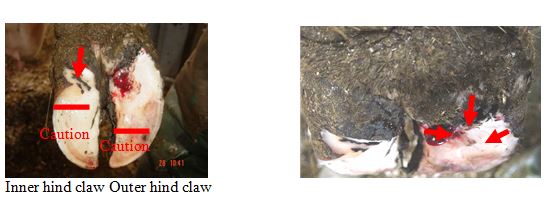
Herd claw trimming regimes
Not all herds benefit from routine claw trimming. Rate of wear depends on abrasiveness of floor surface and the activity of the animals. In extended grazing systems (New Zealand style of dairy farming) wear tends to be high in which case only the lame cows require trimming and even then they may only require the corrective trim (not steps 1-3).
Not all cows benefit from routine claw trimming. Many cows will maintain optimal toe length and balance without need for trimming. Wall horn grows at on average 0.5cm per month, although growth is slowest in the first 4 weeks after calving, at certain times of year and varies with other factors like breed and age. Adopting routine foot checks rather than trimming of every cow is highly advisable.
The optimal times for cows to be inspected and trimmed if necessary include:
- approximately 6-8 weeks before calving, but not on the same day as drying off (potential mastitis risk factor). This restores an optimal foot angle, balance and model as the cow approaches the risk period for sole ulcer and bruising at calving. If first calving heifers have long toes due to a lack of concrete exposure, then trimming at 6-8 weeks prior to calving will also apply. Otherwise avoid trimming heifers prior to calving, especially if heifers are coming in straight from pasture.
- when cows are showing the early visible signs of claw overgrowth or lameness.
- 4-8 weeks prior to turn-out (to remove diseased horn that could attract stones), provided adequate sole depth can be maintained.
- 60-120 days in milk, particularly for high yielding heifers housed on concrete.
- within 6-12 months of calving. This is particularly important to consider in herds with extended lactations, with cows going well over 365 days between calvings (and trimmings).
Routine claw trimming (excluding lameness treatments) should be avoided at certain times, especially:
- when cows are heavily pregnant (within 4 weeks of calving).
- when cows are freshly calved (first 4 weeks of lactation), as cows are under strain and horn growth is less than wear, raising the risk of thin sole after trimming.
- when cows are about to be housed (again, there is a risk of thinner soles and bruising due to horn wear being greater than growth for a few weeks).
- when cows are turned out on very long or abrasive tracks (e.g. tarmac or concrete).
For some herds, the smoothness of the concrete and the high energy/protein diets means claw overgrowth is notable within 3-6 months of trimming. Consequently, every herd is different. Similarly, every cow is different. Therefore, it is probably best to have a system tailored to the individual herds and cows, built up from good records. If this is too complicated, then a regime that means every cow goes through the crush every 3-6 months may be preferred. Inevitably this will mean some cows will be inspected and released without any more than a slight dishing out of the sole. None-the-less, this can be very beneficial for the cow, especially if sole and heel depth can be safeguarded. Alternatively, a system based on good observation of claws and mobility scoring will suit many modern units, especially when thin soles are the main problem.
However, it should be noted that over-trimming can contribute to bruising, lameness and increased risk of future claw overgrowth particularly on farms with sharp, eroded concrete or sand cubicles. Claw trimming can cause some animals distress. This means regimes always need to be tailored to the farm and individual cows, with some trial and error combined with a degree of caution and good monitoring.
Due to the unforgiving nature of concrete, claw trimming technique is extremely important for the health and welfare of the dairy cow. Whilst it is possible to learn the principles by studying written texts, there is no substitute for learning the practical skills with a qualified claw trimming instructor. Small differences in trimming method can have a major impact on claw health and so keeping up-to-date with the latest views on best practice is recommended and probably highly cost-effective. If in doubt about the best way to trim an individual animal, always seek further advice from your veterinary surgeon. Routine foot inspection protocols should be specified as part of your herd health plan.
